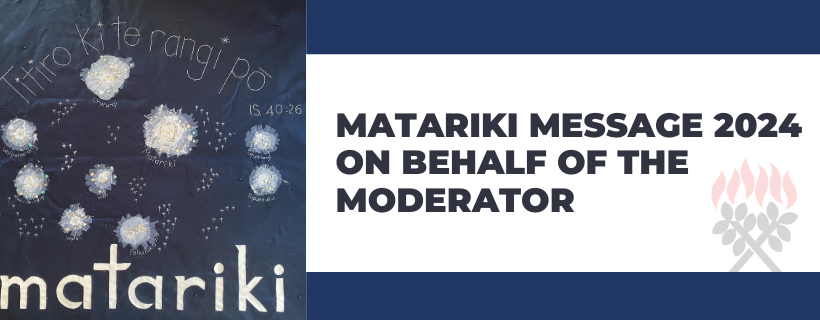Matariki approaches and I hope you are inspired to find ways to celebrate. Although Matariki is still a young public holiday for our country, many now mark this time with the sharing of stories and food, karakia/prayer and waiata/song, and by remembering those who have died and reflecting on hopes for the future.
After consulting with Te Aka Puahou, I have invited the Rev Brendon McRae, minister of Flagstaff Community Church, Ōtepoti, Dunedin, to share a Matariki message with our Church.
Brendon recently completed a Master's degree reflecting biblically on Matariki, and he and Flagstaff Church feature in the recent Shine TV documentary, “God within Matariki” which you can view here.
Rose
Right Rev Rose Luxford
Moderator Presbyterian Church of Aotearoa New Zealand
moderator@presbyterian.org.nz
Download a pdf designed version of this message here and download church Matariki services and resources here.

What’s all this talk about star gazing during Matariki?
The Matariki star cluster (Pleiades) is the oldest and most well-known cluster in the world. According to the ancient scriptures, ‘star gazing’ is nothing new. In the book of Job (thought to be the oldest book in the Bible), God says in response to Job, “Can you bind the chain of the Pleiades?” or translated in te reo ‘Matariki’1.
In the creation narratives, God not only set the stars in place, but ordained the seasons and the New Year. And God said, “Let there be lights in the dome of the sky… and let them be for signs and for seasons and for days and years.2” Interestingly, there were no direct instructions on how a year should be ordered by the heavenly bodies, whether it be by solar (Sun) or lunar (Moon). Light to govern the years and seasons is marked by festivals and sacred rituals.
Traditionally, Māori divided the seasons, months, and nights to bring natural rhythms to their way of life in synergy with the seasons they experienced in Aotearoa. The lunar cycle marked the seasons including the rising of the Matariki constellation signalling the New Year. Matariki rises in the pre-dawn sky and this is celebrated with a vast number of traditional practices important within Te Ao Māori including prayers, feasting, planting and lament.
Friday 28 June marks the Matariki public holiday for the third year since its inauguration in 2022. Thousands of people will be attending events across the country including public lectures, light shows, workshops, kapa haka, dawn services, art exhibitions and dinners. In a national-wide poll conducted by Te Papa Museum, 50% of New Zealanders took action to mark Matariki3. Other research data showed that at least 87% of New Zealanders now have some understanding of what Matariki is about and means4.
Themes of remembering loved ones, looking to the heavens, caring for the environment, lighting candles, feasting and family are alluring to many New Zealanders.
New Zealander of the Year (2023) Professor Rangi Matamua, a pioneer in the re-emergence of Matariki, cements its resurgence saying it is an important symbol of bicultural identity5.
The wisdom of Matariki cannot be ignored. As people of faith, the Treaty, and bearers of the gospel what is our response? A question we ask each year at Flagstaff Community Church as we begin our Matariki preparations is, how might Matariki point to the God we encounter in Jesus Christ who enters both the worlds of Māori and Pākehā? This invites a conversation between scripture, tradition, culture, life and land… and let’s not forget the stars!
Christian worship on a Sunday is simply ‘foreign worship’ if it is not in constant conversation with life outside the church walls. While there are some points of tension and difference, there are a rich number of treasures within mātauranga Matariki that are in harmony with biblical wisdom.
I am increasingly becoming more appreciative of the gift of Matariki as I come to understand and embrace some of the relevant traditional meanings and themes which intersect so well with my life and faith. The three Matariki principles are framed as past, present, and future. Māori traditionally greeted the first sightings of Matariki in remembrance (past), followed by feasting and thanksgiving (present) while setting communal aspirations for the New Year (future). These three principles not only frame human existence and pivot neatly on the turning point of a New Year but underpin the Christian narrative providing rich biblical themes.
A number of key values are associated with Matariki celebrations. Of the 12 Matariki values six are located within the well-known biblical text ‘fruits of the spirit’6 which according to the author Paul, are evident of a life walking in step with God. The gift of Matariki is the invitation to come together regardless of cultural, religious, and ethnic backgrounds. This is part of our Christian DNA with the distinction of being called together ‘in Christ’ who both models and affirms ways of living and behaviour (values).
A growing number of people are taking an interest in the night skies. The Christian community need not be apprehensive about star gazing. The inclusion of the Southern Cross in liturgy is no more sacred than the Matariki star constellation simply because it is in the form of a cross (a form of violent execution). One Bible Concordance reveals a total of 87 references to the words star, stars and starry. When biblical reflection engages with the narrative of Matariki a variety of creative responses emerge that ultimately point to the star creator.
The Christian community is invited to listen deeply to both a Christian Māori perspective on Matariki and Scripture, not to re-colonise it, rather to inform a richer re-telling of Matariki and God’s activity within it.
An excellent resource is the Eco-Church A Rocha Aotearoa NZ website which has a number of Christian resources (including those of the PCANZ). There are liturgies, sermons, videos, family and children's activities, educational resources and more. Ka Rawe!
- Rev Brendon McRae, minister Flagstaff Community Church, Ōtepoti, Dunedin
